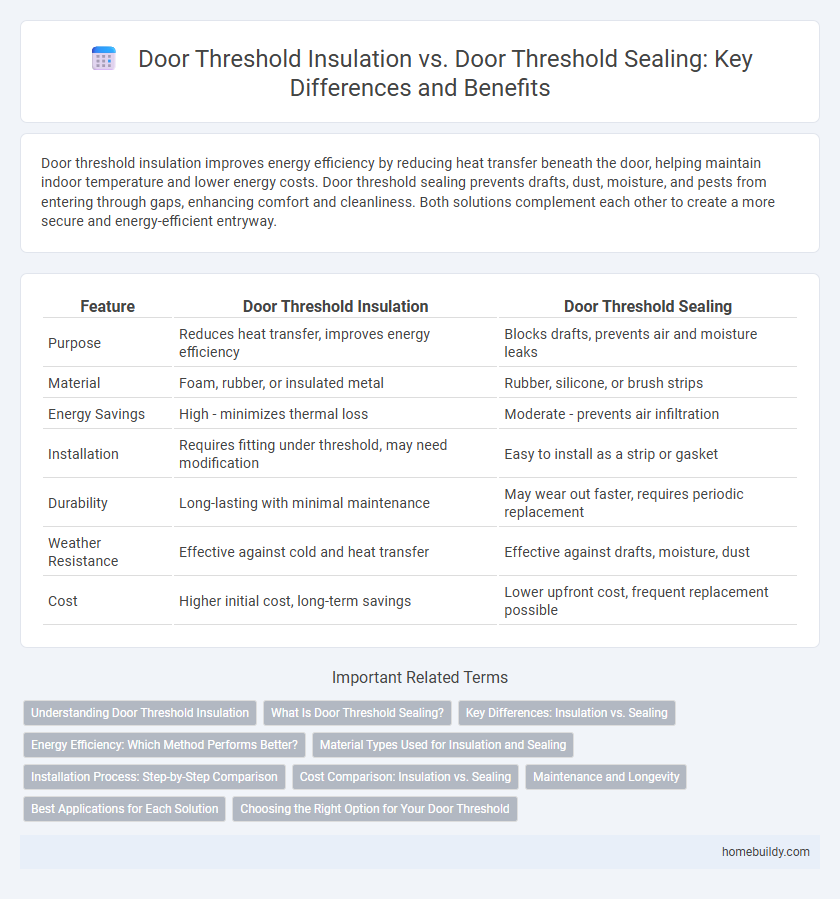Door threshold insulation improves energy efficiency by reducing heat transfer beneath the door, helping maintain indoor temperature and lower energy costs. Door threshold sealing prevents drafts, dust, moisture, and pests from entering through gaps, enhancing comfort and cleanliness. Both solutions complement each other to create a more secure and energy-efficient entryway.
Table of Comparison
| Feature | Door Threshold Insulation | Door Threshold Sealing |
|---|---|---|
| Purpose | Reduces heat transfer, improves energy efficiency | Blocks drafts, prevents air and moisture leaks |
| Material | Foam, rubber, or insulated metal | Rubber, silicone, or brush strips |
| Energy Savings | High - minimizes thermal loss | Moderate - prevents air infiltration |
| Installation | Requires fitting under threshold, may need modification | Easy to install as a strip or gasket |
| Durability | Long-lasting with minimal maintenance | May wear out faster, requires periodic replacement |
| Weather Resistance | Effective against cold and heat transfer | Effective against drafts, moisture, dust |
| Cost | Higher initial cost, long-term savings | Lower upfront cost, frequent replacement possible |
Understanding Door Threshold Insulation
Door threshold insulation improves energy efficiency by reducing heat transfer between indoor and outdoor environments through materials with high thermal resistance, such as foam or rubber inserts. Unlike door threshold sealing, which primarily prevents air, water, and dust infiltration using weatherstrips or gaskets, insulation specifically targets thermal performance to maintain indoor temperature stability. Effective door threshold insulation minimizes energy loss and lowers heating and cooling costs by creating a thermal barrier at the base of the door.
What Is Door Threshold Sealing?
Door threshold sealing involves installing flexible weatherstrips or rubber gaskets at the bottom edge of a doorway to prevent air, water, dust, and pests from entering indoor spaces. This sealing improves energy efficiency by reducing drafts and heat loss while enhancing indoor comfort by blocking noise and moisture infiltration. Unlike door threshold insulation, which focuses on materials that add thermal resistance within the threshold structure, sealing specifically targets creating an airtight barrier between the door and threshold surface.
Key Differences: Insulation vs. Sealing
Door threshold insulation primarily reduces heat transfer by providing a thermal barrier, improving energy efficiency and maintaining indoor temperature. Door threshold sealing, on the other hand, focuses on blocking air, dust, and moisture infiltration, enhancing weatherproofing and preventing drafts. While insulation targets temperature control, sealing ensures a tight, protective closure against external elements and environmental damage.
Energy Efficiency: Which Method Performs Better?
Door threshold insulation enhances energy efficiency by providing a thermal barrier that reduces heat transfer between indoor and outdoor spaces, maintaining consistent indoor temperatures and lowering heating and cooling costs. Door threshold sealing focuses on blocking air leaks and drafts by sealing gaps around the door, preventing energy loss caused by infiltration and improving overall air tightness. Insulation generally offers superior performance in thermal resistance, while sealing ensures minimal air leakage; the best energy efficiency results come from combining both methods for comprehensive protection.
Material Types Used for Insulation and Sealing
Door threshold insulation commonly utilizes materials such as foam rubber, neoprene, and silicone due to their excellent thermal resistance and flexibility, which help reduce heat transfer and improve energy efficiency. In contrast, door threshold sealing often incorporates EPDM rubber, vinyl, and metal strips, offering durable and weather-resistant barriers against drafts, moisture, and dust. Both insulation and sealing materials are selected based on their ability to withstand environmental conditions while enhancing the door's overall performance in temperature regulation and air tightness.
Installation Process: Step-by-Step Comparison
Door threshold insulation involves placing insulating materials such as foam strips or rubber gaskets beneath the door threshold to reduce heat transfer and improve energy efficiency, typically requiring measurement, cutting, and securing the insulation with adhesive or screws. Door threshold sealing emphasizes creating an airtight barrier using weatherstripping or sealing strips applied directly to the door frame or threshold surface, involving cleaning, precise alignment, and fastening for maximum contact. Installation of insulation generally focuses on thermal performance enhancement beneath the threshold, while sealing prioritizes blocking drafts and moisture at contact points, with both methods requiring specific tools and meticulous installation for optimal results.
Cost Comparison: Insulation vs. Sealing
Door threshold insulation typically involves installing materials like foam or rubber strips to reduce heat transfer, often resulting in higher initial costs ranging from $20 to $50 per threshold. Door threshold sealing, which focuses on blocking drafts using weatherstripping or silicone seals, tends to be more affordable, with expenses usually between $5 and $20 per threshold. While insulation may offer better long-term energy savings, sealing provides a cost-effective solution for immediate draft prevention.
Maintenance and Longevity
Door threshold insulation enhances energy efficiency by reducing heat transfer, which minimizes wear on HVAC systems and extends their lifespan. Effective door threshold sealing prevents drafts, moisture, and pests from entering, thereby protecting the threshold material from damage and reducing maintenance frequency. Regular inspection and proper upkeep of both insulation and sealing ensure long-lasting performance and durability of the door threshold.
Best Applications for Each Solution
Door threshold insulation is best suited for improving thermal efficiency in climates with extreme temperatures, as it minimizes heat transfer and enhances energy savings. Door threshold sealing excels in preventing drafts, dust, and moisture infiltration, making it ideal for locations prone to wind or rainfall exposure. Combining both solutions can optimize indoor comfort and protection in environments with varying weather challenges.
Choosing the Right Option for Your Door Threshold
Door threshold insulation enhances energy efficiency by preventing heat transfer through the bottom of the door, making it ideal for maintaining indoor temperature and reducing heating or cooling costs. Door threshold sealing focuses on blocking drafts, dust, moisture, and pests, ensuring a tighter barrier against external elements and improving overall comfort. Selecting the right option depends on your primary needs: insulation for thermal performance or sealing for protection against environmental factors.
Door threshold insulation vs Door threshold sealing Infographic

 homebuildy.com
homebuildy.com